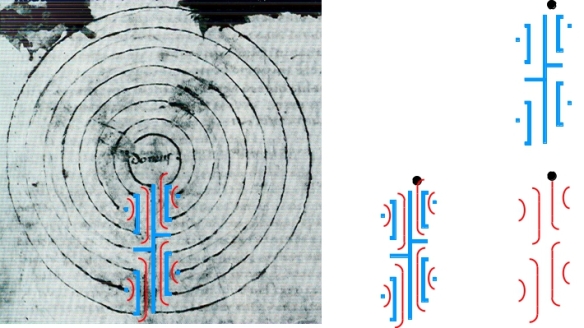The same type of labyrinth can occur in different individual variants. This is also valid for the seed pattern of a labyrinth. In order to show this, I went the opposite way than usual. Instead of completing a seed pattern to the labyrinth, I inscribed the seed pattern in different variants of the Cretan-type of labyrinth. And, as there exist two forms of the seed pattern, I marked them both, the seed pattern for the walls (blue) and for the Ariadne’s Thread (red). Then I extracted the seed patterns and separated them. And, for orientation, I also indicated the localization of the center.
The Pylos labyrinth (fig. 1) has a classical seed pattern for the walls with a central cross, four angles and four dots. This well-known seed pattern thus can be traced back to the earliest securely dated labyrinth at all. Whether the Pylos labyrinth originally was designed from the seed pattern, as many suggest, or not, I leave unanswered here.
Of course, the seed pattern for the Ariadne’s Thread fits into the seed pattern for the walls, since the Ariadne’s Thread follows the pathway between the walls of the labyrinth. The segments of the seed pattern for the Ariadne’s Thread consist of an arc nested into a straight with two rounded angles. These segments are pairwise arranged in vertical and horizontal order.
This arrangement of the segments corresponds with the alignment of the turns of the pathway. In this variant of the Cretan-type labyrinth – on the classic eccentric layout of the Pylos labyrinth – the turns of the inner circuits are aligned along the cross-bar, whereas the outer turns are aligned along the axis. This alignment is characteristic of the classical eccentric layout. (By the way, this can only be observed by viewing the seed pattern for the Ariadne’s Thread. Looking at the seed pattern for the walls, one would rather expect all turns of the pathway to be arranged around the center.)
Fig. 2 shows the seed patterns marked in the labyrinth of the silver coin from Knossos. The central cross of the seed pattern for the walls is easily recognizable. Also, even though not as precise as in the Pylos labyrinth, one can see that the inner turns of the pathway are aligned horizontally, the outer vertically along the axis of the labyrinth. The seed pattern shows, that this labyrinth still preserves essential characteristics of the classical eccentric layout of the Cretan-type labyrinth.
This changes if we mark the seed patterns in the labyrinth of Walahfrid. This fully concentric layout of the Cretan-type labyrinth causes two variations to the seed pattern.
-
The cross-bar of the central cross is split in two halves. The bar on the side where the entrance to the labyrinth is situated, is shifted outside by one unit. This is a result of the centralization of the layout. Not only this bar, but all walls on this side are shifted downwards by one unit.
-
All turns of the pathway are now aligned in parallel with the axis.
One could even abstract this seed pattern further and omit all horizontal branches. This would result in a system of vertical lines and the dots of the seed pattern for the walls.
Related posts:




Pingback: Type or Style / 3 | blogmymaze
Pingback: Variants of the Same Seed Pattern / 4 | blogmymaze
Pingback: Variants of the Same Seed Pattern / 3 | blogmymaze
Pingback: Variants of the Same Seed Pattern / 2 | blogmymaze
Thank you, Andreas,
to open our eyes to see deeper and clearer the structure in reputed wellknown lines of the labyrinth.
LikeLike